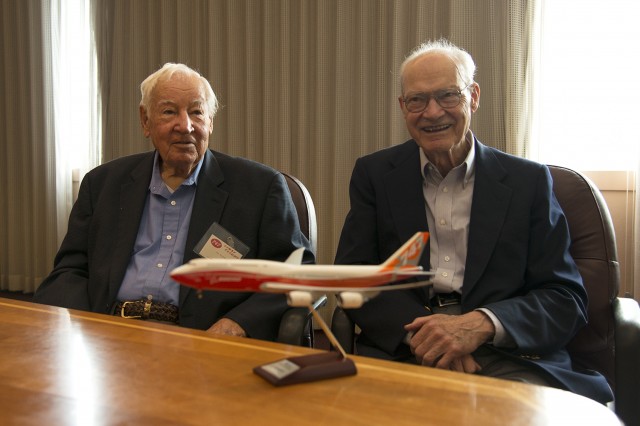
Joe Sutter and Brien Wylge – Photo: Kris Hull
Recently, the Museum of Flight in Seattle finished the first phase of restoring the historic first 747 to its original 1969 appearance. To celebrate this accomplishment, they hosted an afternoon seminar with Joe Sutter, who led the engineering team and is credited as the “Father of the 747”, Brien Wygle, the former Boeing Chief Pilot in 1969 who was in the right seat during the first flight, and noted author Clive Irving, who wrote one of the authoritative books on the 747. Before the main events on October 18th, we had the opportunity to sit down and talk with Sutter, Wygle, and Irving.
The 747 was an aircraft that was developed quickly by today’s standards, according to Sutter. “I was asked to investigate large aircraft designs in April 1965, Pan Am placed its first order in 1966, and we rolled out the first aircraft in 1968, with first flight in 1969, followed by entry into service in early 1970.” For an aircraft the size of the 747, three years from initial concept to rollout of the first model is still today unprecedented.
According to Irving, “It was a large program, and Joe was in the middle of the chain of command, and whenever there was a critical decision to be made, and no one else wanted to make it, Joe made it. He was the one in the end who signed off on everything, and took full responsibility.
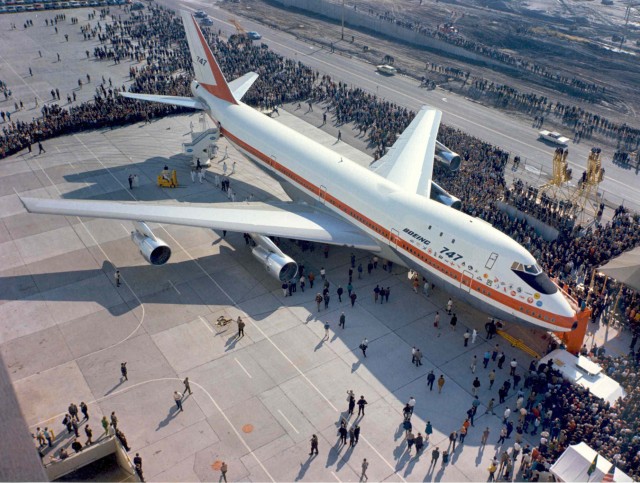
Roll out of RA001, the first 747 – Photo: Boeing
You will not find that speed in today’s environment.”It was a massive undertaking, and at one point, we were spending $5 million a day on the project. I was directed to cut 1,000 engineers by leadership, and I polled my crew and asked what they can do without; they said, ‘nothing, we need 800 additional engineers!'” said Sutter. “We were relegated to an old warehouse on the Duwamish River before the Everett factory was built, while the team heading up the government-sponsored SST program were housed in brand-new offices and buildings.”
When asked about how he felt being “relegated to a side project” compared to the high-profile SST program, Sutter replied, “We had a job to do, and we were going to build an airplane that did that job. We were going to get our job done, and we had the attitude that if we did a good job, the plane would have a great future.”

Media can make things get out of control – Image: Original photo via ChameleonsEye | Shutterstock.com
Full story originally posted on CrankyFlier.com via Brett Snyder…
Had I said to you a month ago that your flight was quarantined because of an Ebola scare, you would have laughed out loud (unless, of course, you’re from Western Africa). But today, that’s the reality. We’re seeing a level of paranoia that is completely unwarranted, and I’m afraid it’s only going to get worse. So, how about we dispel some of these myths? I’ve put together some incredibly useful tips to help.
Yes, there are a couple of cases of Ebola in the US, but in its current state, it’s just really hard to catch the disease. That hasn’t prevented people from freaking out, of course. We can thank the media for that panic with a frenzied level of coverage. On Friday, Delta had a flight quarantined in Vegas. It was United’s turn on Sunday in LA. And you know we’re just going to see more of these.
I’m not a doctor, but I can read. And I know that the Center for Disease Control and the World Health Organization both have websites. That’s enough to qualify me as being able to understand the basics of how this thing works. (You can too unless, of course, you’re a conspiracy theorist who doesn’t believe anything. In that case, enjoy your underground bunker.)
One of the problems with Ebola is that the symptoms start out just like a flu. So as we move into flu season, half the US is going to decide it has contracted Ebola. Airline planners ’“ you might want to start padding your schedules to account for the inevitable quarantines on every other flight. This is not going to work out well unless people take a deep breath and get educated.
Continue reading Let’s Avoid Ebola Paranoia and Stop All These Airplane Quarantines with Some Handy Tips on CrankyFlier.com
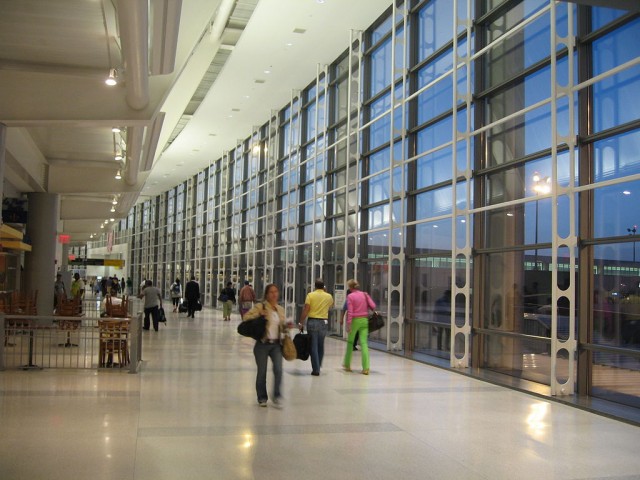
Spending the night on standby in Newark – Photo: Jared and Corin | Wiki Commons
While my experiences of flying standby this summer were filled with many last minute decisions, changing of plans, and an overall change in traveling lifestyle, I never imagined anything crazier than having to fly through an extra city or two to get to my destination. But boy did I think wrong. This in itself showed I’m definitely an amateur.
While I briefly lived in St. Louis for the summer on an airline internship, I was privileged with flight benefits, and took advantage of them whenever I had the chance. Having the ability to visit my family back home in Ohio and New York, in addition to my friends at school down in Florida, was a special opportunity that I really enjoyed! As I dwelled back on my adventures getting through Chicago O’Hare to my various destinations, I realized my craziest experience of flying standby wasn’t yet shared. Being the total nerd that I am, I just HAVE to tell you!
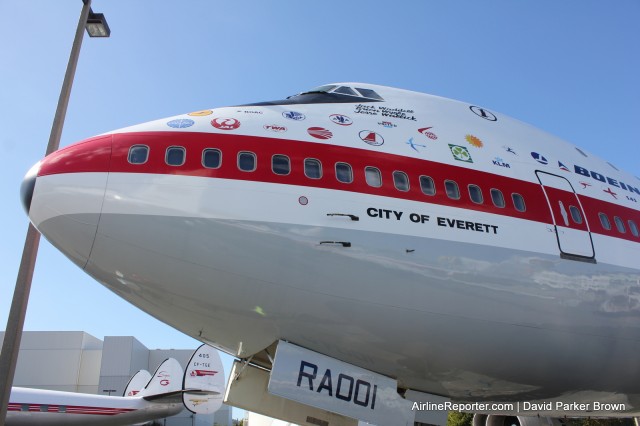
The City of Everett looks great in her new coat of paint
For those of you who have previously visited the Museum of Flight, you know it is a world-class facility and well worth the visit. However, it was always sad looking at the first Boeing 747 sitting outside in bad shape.
As the years passed, the condition of the beauty only got worse. Luckily, things have been changing and now there is one gorgeous Boeing 747 sitting out in the museum’s Airpark.
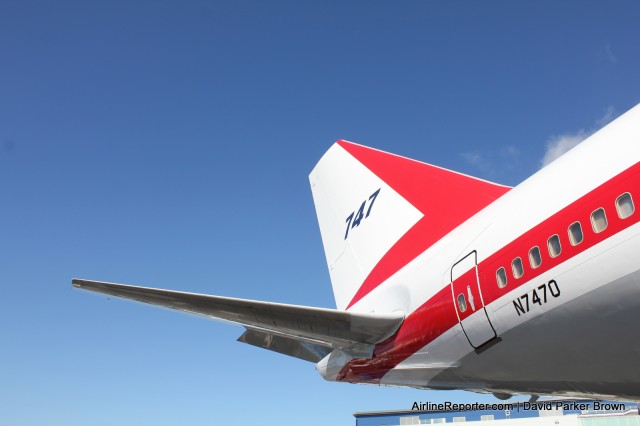
The red on the stripe and tail once again pop
The museum started renovating the interior back in 2013 and then the exterior this July.
The aircraft was not only the first 747 that flew, on February 9, 1969, but it also became a test-bed for 747 improvements and engine developments for the 777’s GE90.
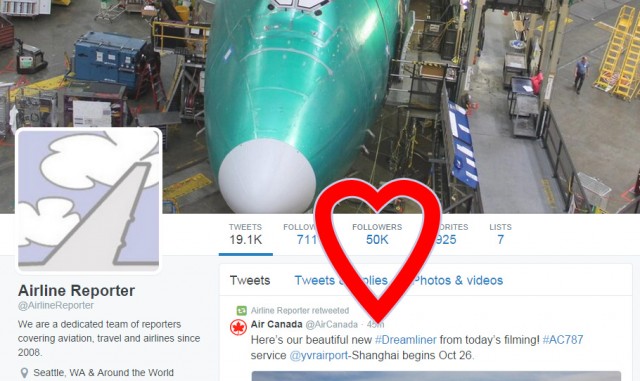
So happy and proud to hit over 50,000 followers — thank you!
I don’t just want to go about tooting our own horn here, but I have to admit that I am pretty darn excited that we hit a big benchmark this morning: obtaining over 50,000 Twitter followers.
I remember way back in the day being super excited about hitting 5,000 and thinking that we would likely settle there. But a huge thank you to all of our fans and readers for making us relevant! The power of having so many fans is that airlines, folks in aviation, and others take notice and give us access to some pretty cool experiences, which we share with you every day.
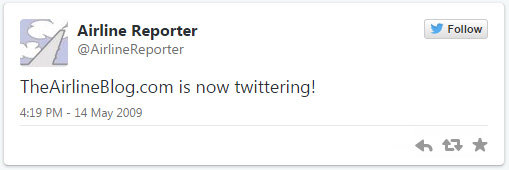
How cute – our first Tweet – made when our name was different
We started on Twitter back in May of 2009. Not really an early adopter, but not late to the game either. Most airlines were not yet on Twitter, and neither were Boeing nor Airbus. I remember being hesitant because I really didn’t get the concept, but people kept telling me that I had to be on it. Now it is a key place where we get our information and leads for stories and it is the go-to source for breaking news.
For a long time, I was @AirlineReporter – it was my personal Twitter account and also the one for the brand. As the AirlineReporter team grew, it didn’t make much sense to use it personally, and I broke off with using @ARdpb for my personal stuff (although it is still 95% airplane-related) and keeping @AirlineReporter for the brand.
Getting to this point has been a big team effort. Not just our amazing writers who are producing the content, but others like @NYCAviation, @AirwaysNews, @RunwayGirl, @JonOstrower, @AirlineFlyer and many more on Twitter who have been following, supporting, and sharing our Tweets for years.
If you aren’t one of the cool kids already, be sure to follow us on Twitter (while you are at it, you might as well like us on Facebook too).
We will try to keep on growing and welcoming new readers, while still staying loyal to who we are and respecting the fans who have been with us for years.
Tell me – when did you start following us?







